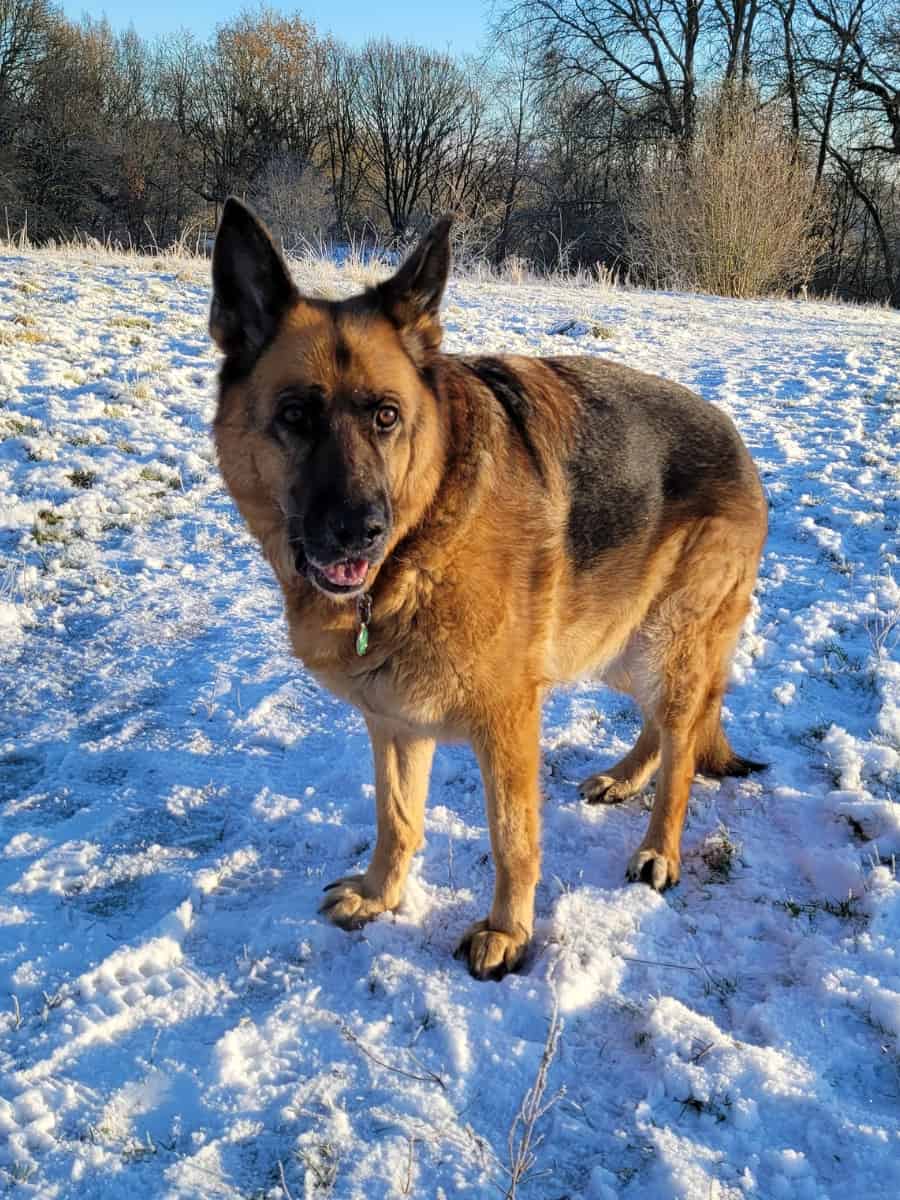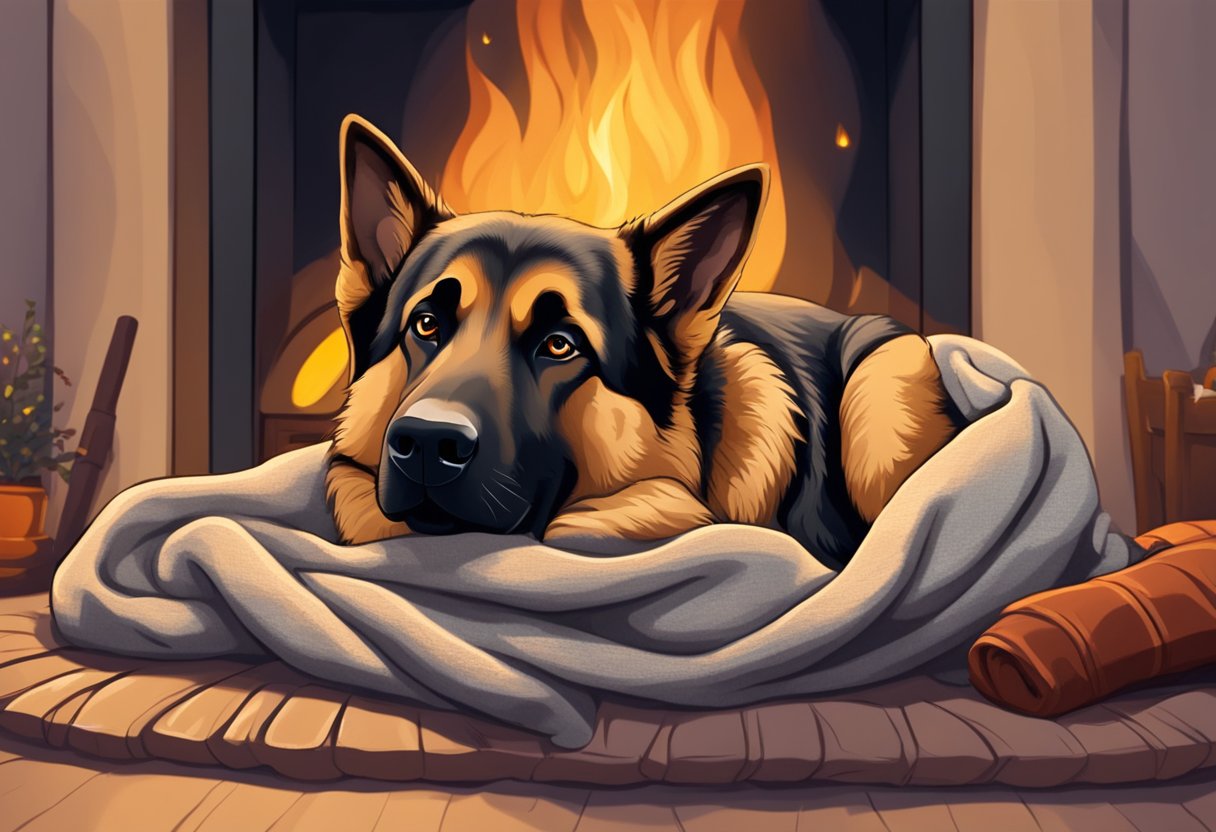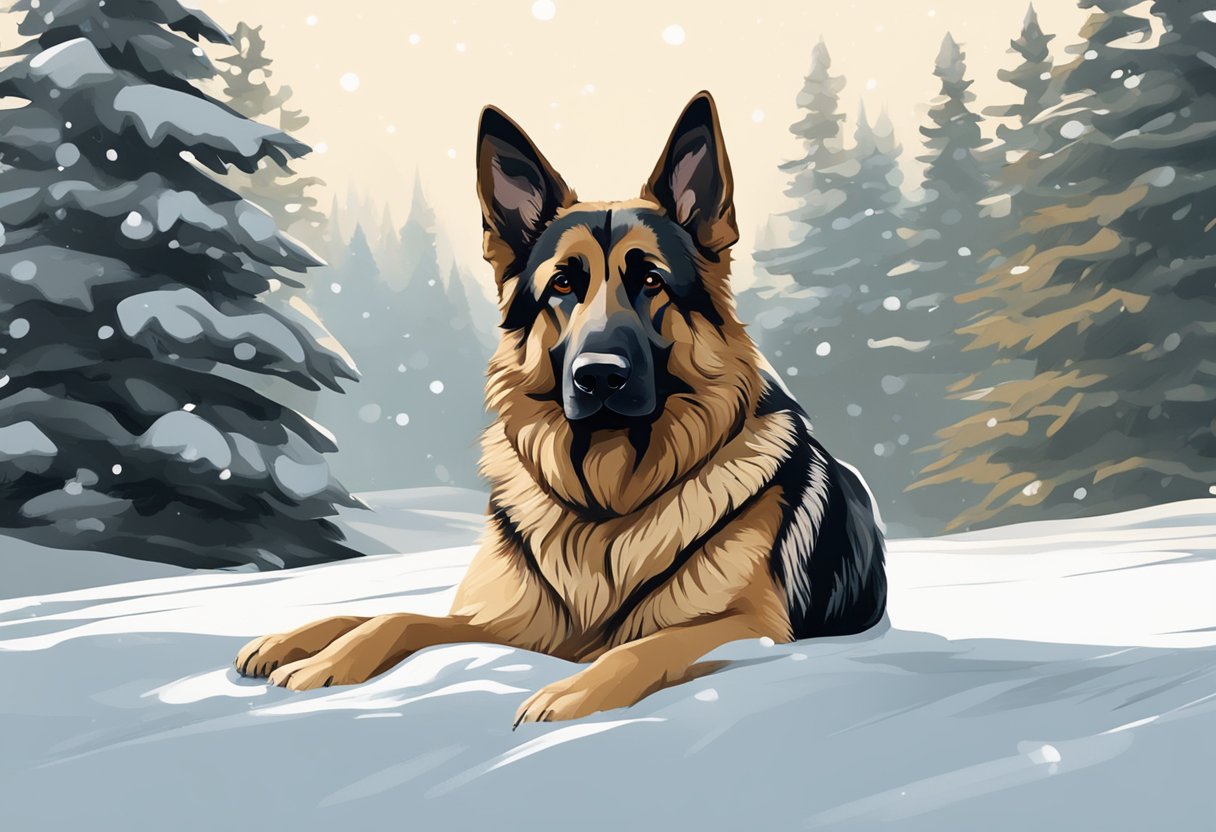Do you often wonder if your German Shepherd gets cold during the winter months?
German Shepherds do get cold. However, they are better equipped to handle lower temperatures thanks to their unique double coat. Their coat provides insulation and protection from harsh weather conditions, helping them to tolerate cold temperatures better than most breeds.
That being said, how cold is too cold for your furry friend depends on several factors, such as your dog’s age, health, activity level, and overall size.
While some German Shepherds can comfortably withstand colder temperatures, others might be more sensitive and require additional help staying warm, especially during extreme weather conditions.
Key Takeaways:
- German Shepherds have a double coat that helps them tolerate cold temperatures better than most breeds.
- Factors such as age, health, and size may affect a German Shepherd’s cold tolerance.
- It’s important to recognize signs of discomfort in your German Shepherd and provide the right protection from cold weather.

Understanding a German Shepherd’s Coat
Importance of the Double Coat
German Shepherds possess a double coat that consists of two layers: the undercoat and the outer coat. This unique feature helps protect them from various weather conditions.
The dense undercoat provides insulation, keeping your furry friend warm during cold temperatures.
The outer coat, which is thicker and harsher, serves as a barrier against rain, snow, and dirt. In addition to protection, their double coat also allows German Shepherds to better tolerate colder temperatures than other breeds.
Shedding and Coat Health
It is important to understand and manage your German Shepherd’s shedding to maintain their coat health. Here are some key points to keep in mind:
- Regular brushing: Brushing your German Shepherd’s coat will not only remove dead hairs but also promote healthy circulation and redistribute their natural oils.
Bathing: Regular baths can help to keep their skin healthy and prevent matting. Make sure to use a mild, dog-specific shampoo.
Nutrition: Feeding your German Shepherd a high-quality, balanced diet can help to support coat health and minimize excessive shedding.
By paying attention to these aspects, you can ensure that your German Shepherd’s double coat stays in top condition, providing them with the optimal protection and insulation they need.
Factors Affecting Cold Tolerance in German Shepherds
German Shepherds love the snow.
My German Shepherd Willow loves to frolic in the snow with boundless joy, her tail wagging wildly as she dives into the fluffy white blanket with sheer delight.
But let’s explore the factors affecting their cold tolerance.

Age and Health Considerations
When it comes to cold tolerance, the age and overall health of your German Shepherd play a crucial role.
Puppies are generally more sensitive to cold temperatures because they have less body fat, and their double coat isn’t fully developed yet.
Older dogs may also have a harder time in colder weather due to joint pain and other age-related health issues. You must take your dog’s age and health into account when assessing their tolerance for cold weather.
The Role of Diet and Exercise
Proper diet and exercise can have a significant impact on your German Shepherd’s cold tolerance because they help maintain a healthy weight and energy levels.
Diet: A well-balanced diet is essential for German Shepherds to maintain a healthy weight and provide the necessary nutrients to regulate body temperature and generate heat.
Foods rich in protein and fat can help sustain your dog’s energy levels, enabling them to better withstand cold temperatures.
Exercise: Regular exercise is crucial for keeping your German Shepherd’s energy levels up, especially during colder months. Exercising can help them generate body heat, maintain muscle mass, and improve their health.
Keeping Your German Shepherd Warm

Proper Shelter and Bedding
During cold weather, you must provide your German Shepherd with proper shelter. If they’re mostly staying indoors, ensure that your home is well-insulated and maintain a comfortable temperature. A warm and cozy environment is crucial for their well-being.
Consider providing your dog with a suitable bed, preferably raised off the floor, to avoid drafts. Adding blankets for extra insulation can also help keep your furry friend snug and warm during cold temperatures.
Appropriate Clothing and Accessories
Apart from providing a warm and comfortable shelter, you might also want to consider clothing and accessories for your German Shepherd.
A well-fitted dog jacket can help keep them warm and protect against harsh weather elements, especially if they have a short or single coat. Ensure the jacket covers their chest and belly for maximum warmth.
Additionally, consider investing in dog boots to protect paws from ice, snow, and salt.
Paw balms are another option for protecting your dog’s paws from getting dry and cracked during cold weather.
These small steps can go a long way in ensuring your German Shepherd stays warm and comfortable during chilly times.
Recognizing and Preventing Cold-Related Issues

Signs of Hypothermia and Frostbite
As a German Shepherd owner, you must recognize the signs of hypothermia and frostbite.
- Hypothermia occurs when your dog’s body temperature drops significantly below normal. Some early symptoms of hypothermia include shivering, lethargy, and decreased energy levels.
As the condition progresses, your German Shepherd may exhibit signs of confusion, weakness, and slow or shallow breathing.
- Frostbite happens when your dog’s skin and tissue freeze due to exposure to cold. The most susceptible areas for frostbite are the ears, tail, and paws.
Look for pale, gray, or blue skin, which may turn red and swollen when it warms. If you notice any of these signs, it is essential to get your German Shepherd inside and seek veterinary help immediately.
Promoting Good Health in the Winter
To ensure your German Shepherd stays healthy and comfortable in cold weather, follow these tips:
- Proper Shelter: Make sure your dog has a warm and dry place to rest, especially when outdoors. Provide a well-insulated dog house with a door flap to keep out drafts and bedding to help retain body heat.
- Grooming: Regular grooming helps to maintain the insulating properties of your German Shepherd’s double coat. Brush their coat regularly to remove any dead hair, and avoid shaving them during winter months.
- Adapt Exercise: German Shepherds are energetic dogs, but you should be mindful of their exposure to cold weather. Keep outdoor exercise sessions short and consider indoor alternatives if the temperature is below 20°F (-6°C).
Paw Protection: Use pet-safe ice melt products and consider using dog boots or apply a paw protectant balm to help prevent injuries from ice, snow, and salt.
Nutrition: During winter, your German Shepherd may require more calories due to increased energy needs for maintaining body temperature. Consult your vet for dietary recommendations based on your dog’s specific needs.
By keeping an eye on your German Shepherd’s health and comfort in cold weather and addressing any potential issues early, you can ensure they remain happy and healthy all winter.
FAQs

At what temperature does a German Shepherd need a jacket?
While German Shepherds have a dense, double-layer coat, they can still feel cold in lower temperatures. Generally, anything below 40°F (4.44°C) may be too cold for them, and they might need a jacket source.
How can I tell if my German Shepherd is feeling cold?
To determine if your German Shepherd is feeling cold, watch for signs such as shivering, seeking warmth, curling up to conserve body heat, and slowing down during walks. If they start lifting their paws off the ground or appear uncomfortable, they probably feel cold.
What is the ideal temperature range for a German Shepherd puppy?
German Shepherd puppies can tolerate a safe temperature range between 50°F and 80°F (10°C to 27°C). However, they may be more sensitive to colder temperatures due to their developing immune and temperature regulation systems.
How well do German Shepherds tolerate hot weather conditions?
German Shepherds are better suited for colder climates, but they can also tolerate moderate heat. Remember that they can overheat if temperatures go beyond 86°F (30°C).
You must provide them with enough shade, water, and opportunities to cool off during hot weather.
Can a German Shepherd safely stay outside during winter?
German Shepherds can stay outside for a limited period during winter weather, but it is crucial to carefully monitor them for any signs of discomfort or cold-related issues. It is recommended that you provide a warm shelter for them to retreat to if the temperature drops significantly.
Related Posts You May Like:





